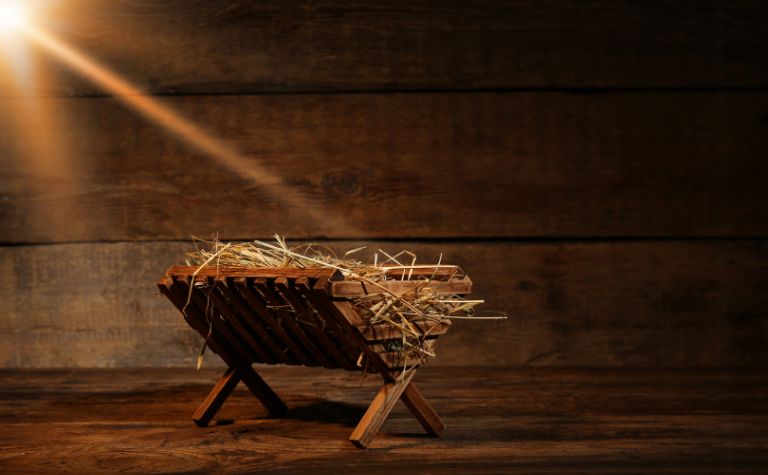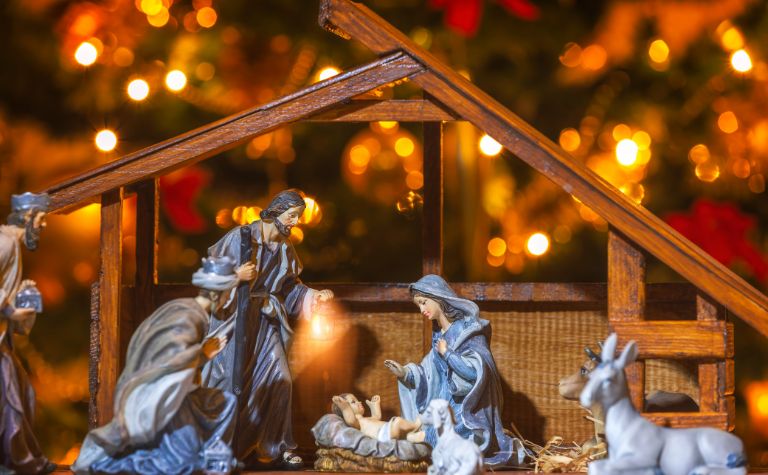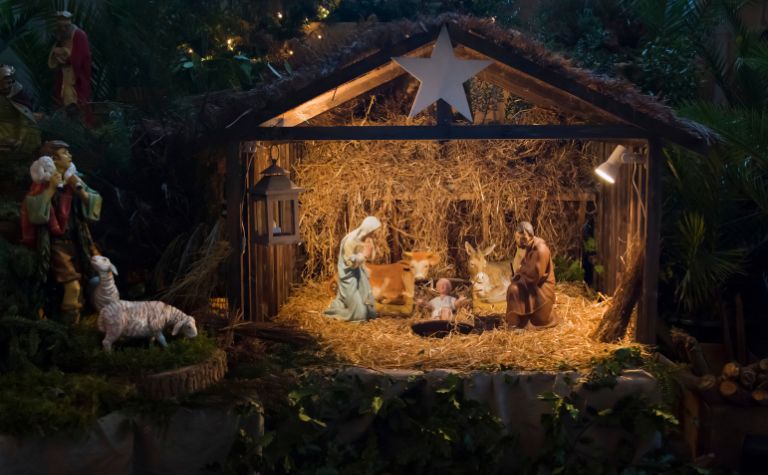The Nativity scene remains a captivating representation of the birth of Jesus, uniting people from varied backgrounds during the festive season.
Regardless of its scale or intricacy, each scene captures a narrative brimming with profound themes and symbols. Here, we further explore this tradition’s rich facets.
As the festive season commences, the Nativity scene emerges as a central emblem of the Christmas celebration.
Its tableau, illustrating the birth of Jesus in Bethlehem, transcends cultural and geographical boundaries, transforming from a biblical recounting to a symbol resonating with individuals worldwide.

1. Origin and Early Depictions of Nativities
The creation of the first living nativity in Greccio, Italy, in 1223, marked the beginning of a tradition that would span continents and centuries.
St. Francis of Assisi, a revered figure known for his deep love for nature and humanity, conceived this innovative way to present the story of Jesus’ birth.
He sought to make the biblical narrative more tangible and relatable to the people of his time, eschewing grand cathedrals or lavish settings for a more authentic backdrop: a real cave with live animals, and humans portraying Mary, Joseph, and the shepherds.
This groundbreaking representation became a catalyst for a broader embrace of the Nativity scene.
The visual, almost theatrical nature of this depiction engaged the senses and emotions of its audience, offering a vivid and immersive recounting of a sacred story.
As word spread of this evocative method of celebration, it wasn’t long before the tradition found its way into churches, public squares, and homes.
Over time, as the tradition migrated across regions, local influences began to play a part in the portrayal of the Nativity, leading to a rich tapestry of interpretations, each adding layers of cultural and historical context to the foundational narrative from Greccio.
2. Central Nativity Figures: Mary and Joseph
In the heart of the Nativity scene stand Mary and Joseph, symbols of unwavering love, sacrifice, and devotion.
Their presence in the tableau is not merely about their physical proximity to the infant Jesus but also about the roles they played in this monumental narrative.
Mary, often depicted in hues of blue, represents purity, grace, and compassion.
Her demeanor in the Nativity scenes, whether looking lovingly at her newborn or in contemplative prayer, encapsulates the enormity of her role as the mother of Jesus.
Her portrayal seeks to capture a mother’s simultaneous joy and apprehension, knowing the significant path her child is destined for.
Joseph, typically shown standing or leaning protectively near Mary and Jesus, embodies responsibility and guardianship.
Often with a lantern or staff in hand, he is the silent protector, guiding his family through uncertainties, be it during their journey to Bethlehem or their flight to Egypt.
His portrayal in the Nativity emphasizes the strength and fortitude required to support and safeguard his family amidst challenges.
Together, Mary and Joseph’s depictions in the Nativity scene serve as a testament to their pivotal roles.
They are the pillars upon which the story unfolds, their unwavering faith and commitment setting the stage for the events of that holy night.

3. The Infant Jesus: the Focus of the Nativity
At the epicenter of the Nativity scene lies the figure of the infant Jesus, symbolizing hope, love, and a new beginning for many believers.
This tiny representation, usually placed on a manger’s soft hay, is more than just a depiction of a newborn; it encapsulates a moment that would redefine the course of history for many.
The manner in which Jesus is portrayed varies.
In some scenes, the emphasis is on his vulnerability and innocence as an infant, highlighting the humility of the divine choosing such a humble entrance into the world.
Wrapped in swaddling clothes, this portrayal invites onlookers to ponder on the profound juxtaposition of divinity in such a tender form.
In other representations, the infant Jesus is shown with outstretched arms, almost as if in a gesture of blessing or embrace.
This posture, even as an infant, serves as a reminder of his role as a beacon of love and unity.
Regardless of the specific depiction, the figure of the infant Jesus remains the fulcrum around which the entire Nativity scene revolves.
His presence underscores the significant message of humility, sacrifice, and divine love, resonating deeply with those who pause to contemplate the scene.
4. The Shepherds
The inclusion of shepherds in the Nativity scene offers a rich narrative layer underscoring the universality of the event it commemorates.
As humble keepers of flocks, shepherds represented the everyday individual, living simple lives away from the societal spotlight.
The biblical account highlights that shepherds were among the first to receive the news of Jesus’ birth.
This is significant, as in a time where hierarchies and societal standings were strictly delineated, the divine chose to announce this miraculous birth to those on the margins first.
Their presence in the Nativity scene is a vivid testament to the idea that profound events can touch even the most ordinary lives.
Often depicted in awe and wonder, the shepherds’ reactions resonate with many.
Their astonishment, curiosity, and immediate decision to journey to Bethlehem speaks volumes about human nature’s innate desire to seek and witness the extraordinary.
Furthermore, their portrayal, typically with staffs in hand and sometimes accompanied by sheep, adds a layer of authenticity to the scene.
Their rustic attire and rugged demeanor contrast beautifully with the divine elements, reinforcing the overarching theme that the divine can intersect with the mundane, and that miracles can be woven into the fabric of everyday life.

5. The Magi or Wise Men
The Magi, often referred to as the Three Wise Men or Kings, introduce a layer of mystique and global reverence to the Nativity scene.
These distinguished travelers from the East, guided by the Star of Bethlehem, embarked on a dedicated quest to find the newborn king, a journey marked by both physical distance and spiritual significance.
These figures represent more than just the elite or scholarly class of their time.
Their journey signifies dedication, wisdom, and the deep human desire to seek and honor the divine. Laden with gifts of gold, frankincense, and myrrh, each offering carries symbolic importance.
Gold symbolizes royalty; frankincense, often used in worship, indicates the divine nature of the infant; and myrrh, a preparation for burial, is seen as a foreshadowing of the challenges Jesus would face.
In many depictions, the Magi are shown in varied attire, emphasizing their diverse origins and the universality of the event they came to witness.
Their inclusion in the Nativity scene serves as a reminder that the birth of Jesus had implications and drew reverence far beyond the immediate surroundings of Bethlehem.
Ultimately, the Magi encapsulate the idea that true wisdom lies in recognizing and revering the divine, transcending borders and societal standings.
6. The Angels
Beyond mere messengers, angels in the Nativity scene often exude an ethereal glow, symbolizing the bridge between the terrestrial and celestial.
Their postures, either in proclamation or silent admiration, reinforce the significance of the birth below.
7. Animals in the Scene
Beyond mere background elements, the animals enrich the scene’s texture.
An ox and a donkey, providing warmth, highlight nature’s role in cradling the divine.
Regional variations, introducing local fauna, create a sense of familiarity and belonging.
8. The Star of Bethlehem
More than a mere celestial body, this star encapsulates guidance, hope, and revelation.
Its brilliance, often exaggerated in depictions, serves as a beacon, emphasizing the unparalleled significance of the event it illuminates.
9. Setting and Backdrop
The humbleness of the stable or cave, often rustic and unadorned, starkly contrasts with the monumental event it hosts.
This setting underscores a profound theme: that greatness can emerge from simplicity, and that divinity can touch even the most modest of surroundings.
10. Global Variations
Cultural interpretations of the Nativity scene weave a rich tapestry of global heritage.
While the core narrative remains consistent, regional nuances—be it in attire, additional characters, or local customs—enrich the tradition, showcasing the Nativity’s adaptability and universal appeal.
11. Evolution Over Time
As with many traditions, the Nativity scene has undergone changes since its inception.
Initially, nativity scenes, particularly in Europe, focused intently on the holy family and essential biblical figures.
Over time, and especially during the Renaissance, artists and communities began adding more intricate details to the tableau.
Features such as detailed landscapes, additional characters like townspeople, and more intricate stable or surrounding structures architecture were included.
These additions added depth and complexity to the visual representation and reflected the times and prevailing artistic trends.
Furthermore, with the advent of modern technology, many Nativity scenes today incorporate lighting, sound, and even moving parts to bring the scene to life, making it a dynamic and immersive experience for onlookers.
Conclusion
With its deep historical roots and profound symbolism, the Nativity scene has evolved over the centuries, capturing the imaginations of generations.
Its adaptability across various epochs and cultures is a testament to its universal appeal and timeless message.
As it continues to morph with contemporary interpretations, the Nativity scene remains a cherished emblem of the festive season, inviting global audiences to pause, reflect, and unite under its age-old narrative.
Related Questions
Joseph, the husband of Mary and the earthly father of Jesus Christ, is depicted in the Gospels as humble, law-abiding, and obedient. In many Christmas scenes, such as in displays of the manger, he is...
The virgin Mary, the mother of Jesus, is one of the most fascinating people in the Bible. For 2,000 years, people of different eras and cultures have marveled at her faith in God. Mary's story in the...
